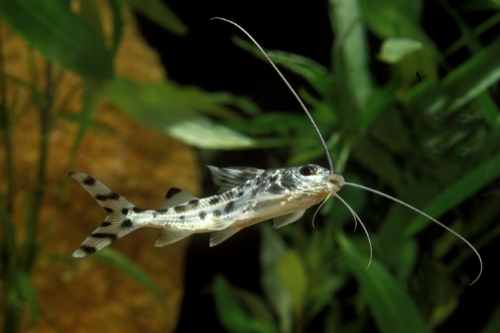Pictus catfish is among the most popular freshwater fish species. Fish-loving breeders are interested in them for a variety of reasons.
Pictus catfish are an excellent choice for your home aquarium or a community tank, thanks to their vibrant contrasting dark colors dots on a silvery-white body and their highly entertaining and energetic behavior. They are incredibly active, move quickly, and are extremely attractive.
Pictus catfish are mainly nocturnal and are drawn to their high energy and long barbels. These types of catfish are not violent and may coexist with other fish species once they have become accustomed to their new surroundings.
Pictus cats are mainly sold as wild-caught youngsters between the size of 5 and 7.6 cm. They rarely exceed 12.7 cm in aquariums; however, there have been cases of fish reaching 15.2 cm or larger in the wild.
A full-grown Pictus catfish will normally get 4.5 inches in length when kept in a 208-liter tank. If you want this type of catfish to hit its full potential, you’ll need a tank with at least 757 liters of space.
Table of Contents
Time Required for the Full Growth of a Pictus Catfish
Pictus catfish fry requires 8 to 12 months to mature into full-grown adults. Genetics, diet, water parameters, aquarium size, and tank mates are some of the factors that can affect its development. Keep your eyes peeled for any strange behavior or stumbling blocks to their development.
Ensure they have nutritious food and are kept in the proper circumstances with the right tank mates.
What are the Reasons a Pictus Catfish Might Stop Growing?
Many fish owners find it strange when their precious fish abruptly stop growing. The Pictus catfish could go months without developing even a smidgeon. There could be several causes for this, and fortunately, most of them are within your control.
Those that you can regulate are all environmental, which means you can take action right away.
Pictus Catfish Genetics
The Pictus Catfish is biologically programmed to reach a maximum size of 12.7 cm. That is true regardless of whether they dwell in the wild or an aquarium. As a result, putting them in an aquarium that is less than 189 liters is essentially torturous for them.
Although there will be no visible growth on the exterior, their organs will continue to develop on the inside. In the long term, this brings them a lot of stress and misery. It will generate a lot of tension, which will lead to odd behaviors like rushing into the aquarium glass all the time.
Pictus Catfish Water Parameters
The Pictus catfish requires clean water. Consider the fact that 25 % to 35 % of the water must be replaced every two weeks. There are numerous impurities that can accumulate in the water and make these fish ill. It may even stifle their development since they will become unwell and anxious.
It’s best to maintain the water clean and all of the variables within approved limits. The temp must be between 75 and 81 degrees F, and the pH level should be between 7.0 and 7.5.
A test kit must be kept on hand to keep water parameters under control.
Pictus Catfish Aquarium Size
It’s critical to keep your Pictus catfish in a large sufficient aquarium. A 189-liter tank is required for even one fish of this type. Many new fish keepers make the mistake of trying to keep them in a 38-liter tank just to discover that it stresses the fish out and prevents it from developing.
If your fish is constantly hitting the aquarium glass during the day, there could be a significant problem. It simply implies that your Pictus catfish tank is too tiny, and your fish is going insane. The Pictus catfish’s organs continue to expand, but it is unable to grow in size due to a lack of space in the tank.
If you don’t want your catfish to suffer and become sick, buy a larger tank.
Pictus Catfish Tank Mates
Pictus catfish must only be maintained with other fish that are suitable for them. There are many catfish that are aggressive, extremely active, and even greedy. Verify that they will not be bullied, injured, or possibly eaten. Also, stay away from fish who are always stealing their food.
Maintaining them in an aquarium with several tank mates could also be problematic. Overcrowding in an aquarium can have the same negative consequences as having them in a very small one. It’s advisable to introduce tank mates slowly and observe their behavior each day. Both anxiety and a shortage of food might stifle your fish’s development.
Pictus Catfish Diet
Whatever food you put in the aquarium, your Pictus catfish will almost certainly devour it. Things aren’t always as simple in a large communal tank with a lot of tank mates. You could feed them all three times per day, but several of your catfish will eat more quickly than others.

